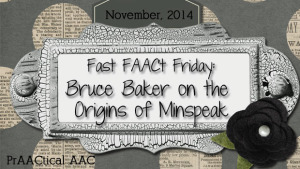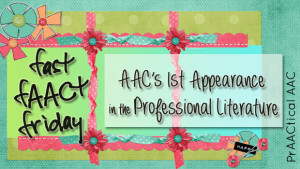November 7, 2014
by Carole Zangari -

Some of the most powerful AAC devices in the world were inspired by hieroglyphics. We’re wrapping up the week by going back to the beginnings…of Minspeak, that is. In this video, Bruce Baker takes us back to 1980 when he used his background in classical languages and hieroglyphics to develop ‘Minimum Effort Speech,’ or Minspeak. Take a look.
Filed under: PrAACtical Thinking
Tagged With: AT history, Bruce Baker, fast fAACt, Minspeak
November 15, 2013
by Carole Zangari -

Today’s Fast FAACt deals with the origins of AAC in clinical practice. Many people assume that AAC is a new field. While it certainly doesn’t have as long a history of as articulation or fluency disorders, neither did it just pop up in the last decade. Or the the previous one, or the one before that. When did AAC first appear in the professional literature? If you guessed the 80’s,you’re off by a bit. the 1970’s? Not quite. As far as we can tell the first published article on augmentative communication strategies was in the early 1950’s. The topic? Augmenting communication for people with aphasia. Here’s the reference: Goldstein, H., & Cameron, H. (1952) New method of communication for the aphasic patient. Arizona Medicine, 8, 17-21.
Filed under: PrAACtical Thinking
Tagged With: AT history, historical perspective, literature

